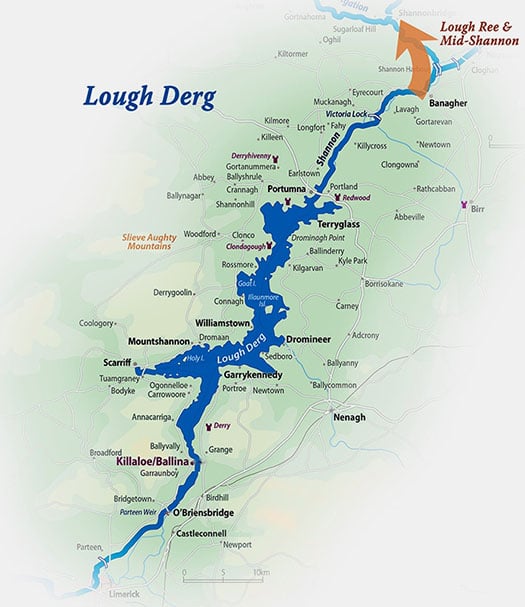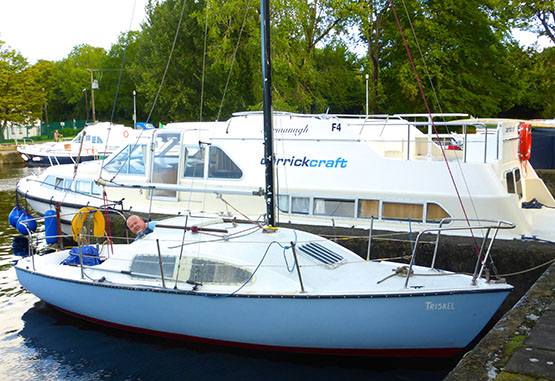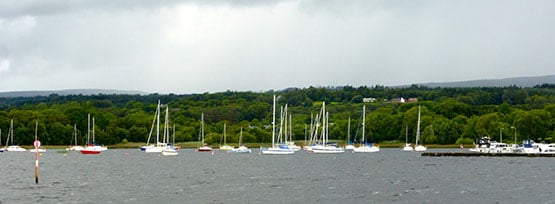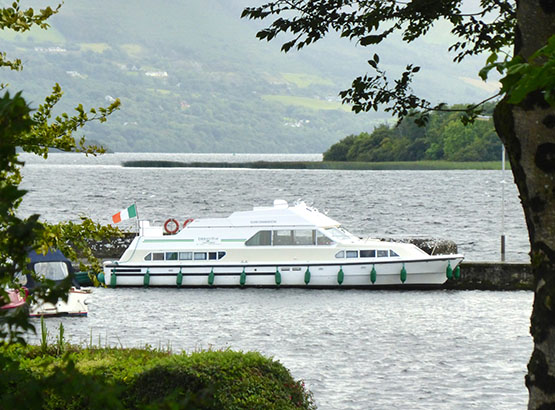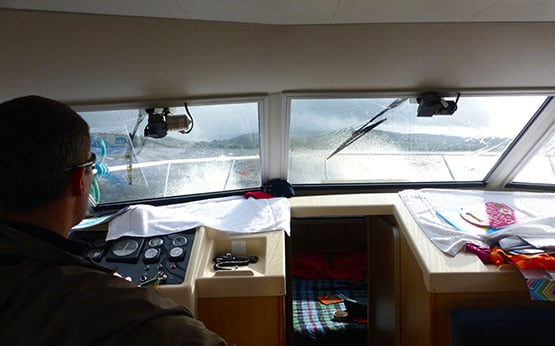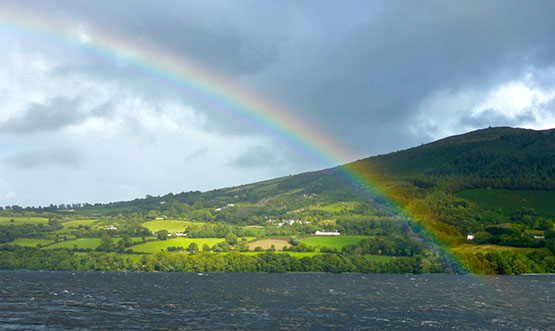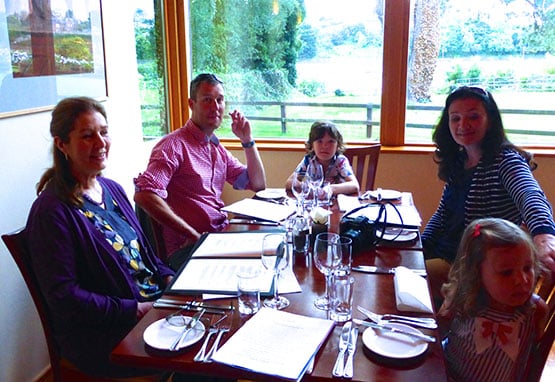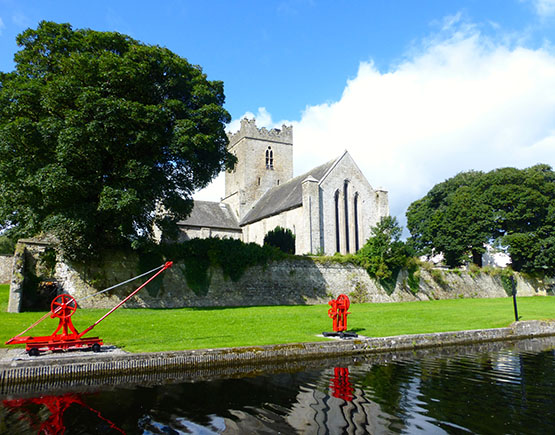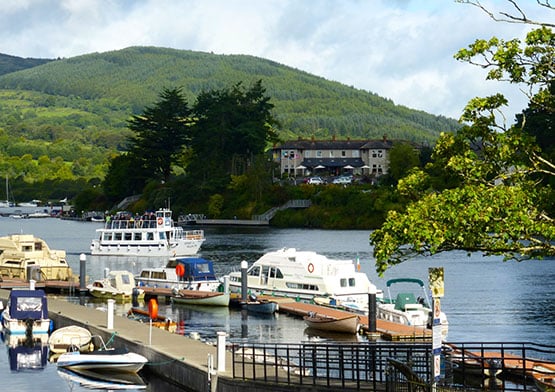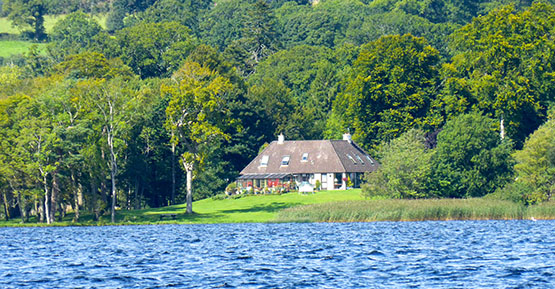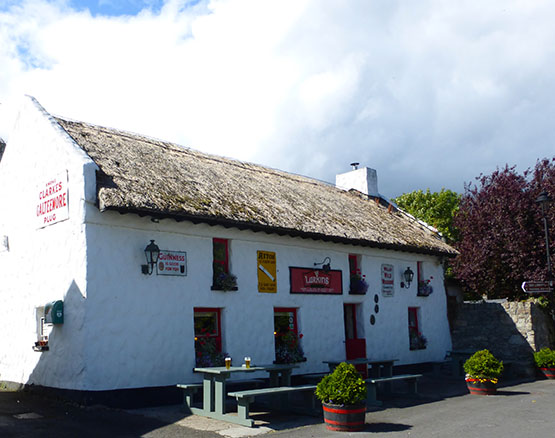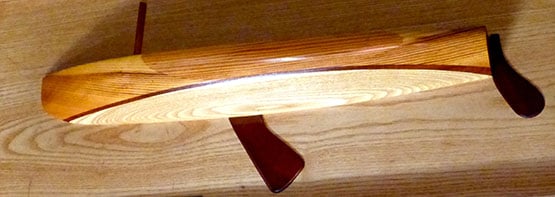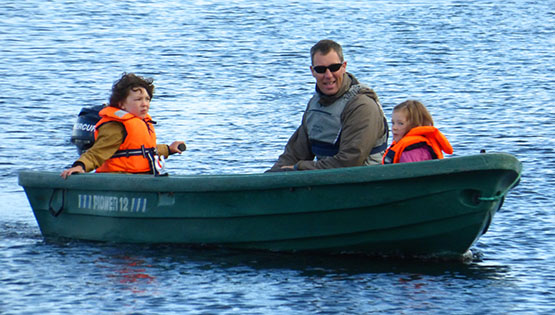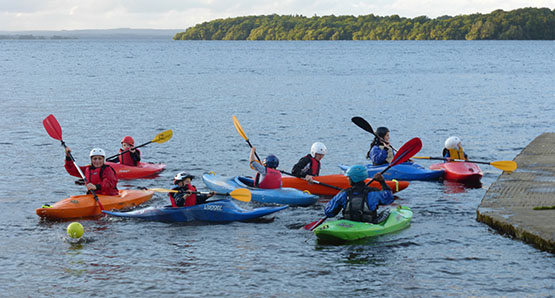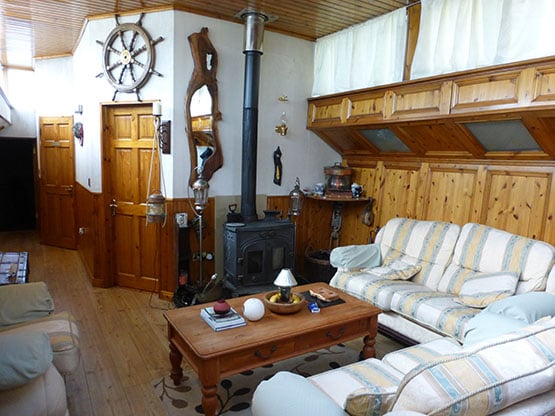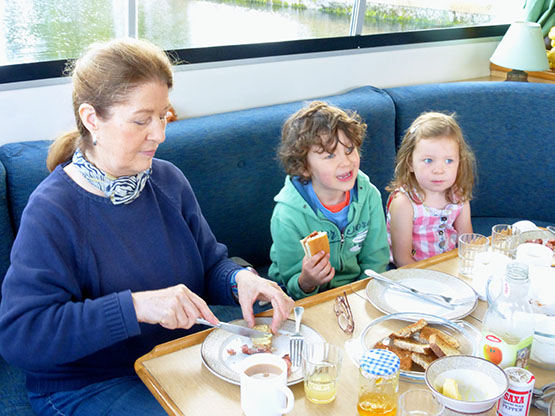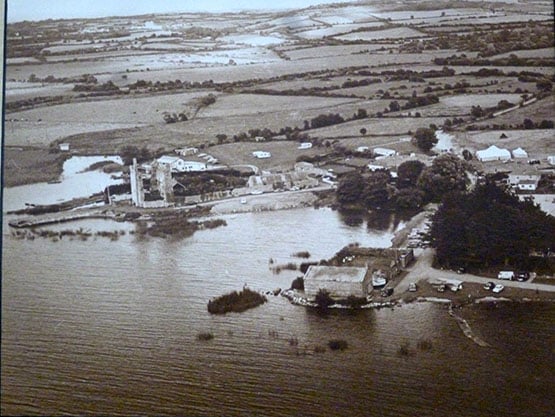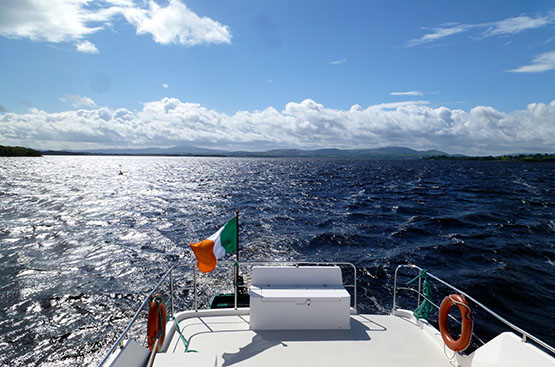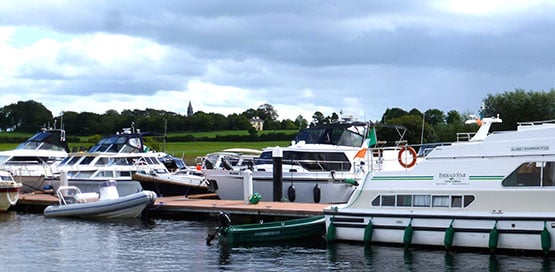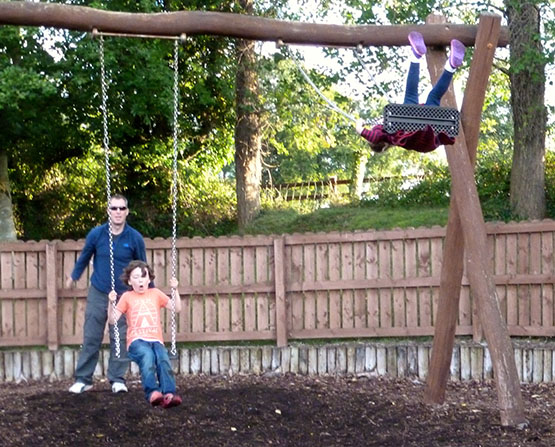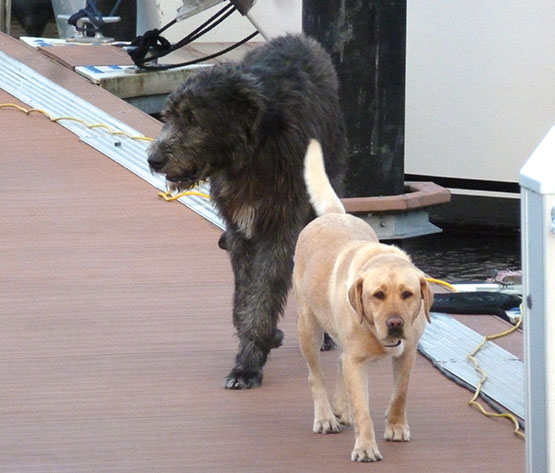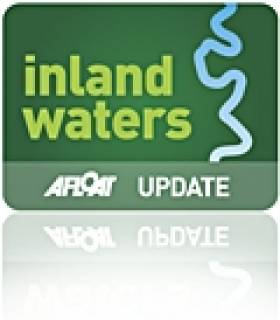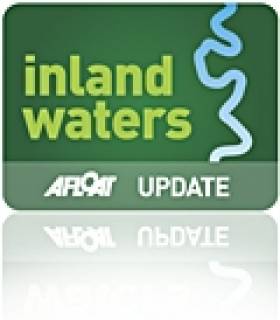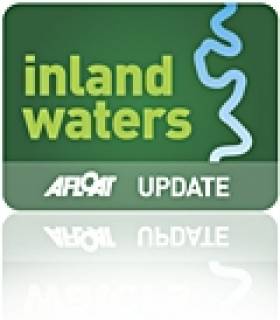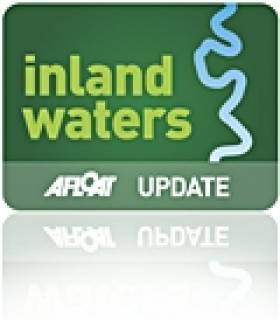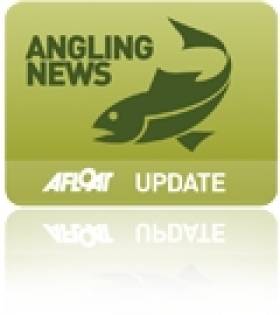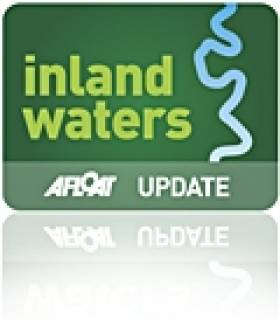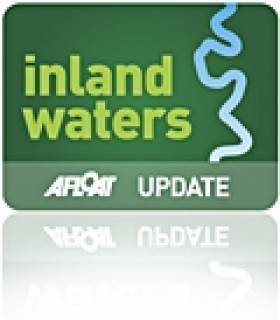Displaying items by tag: inland waterways
Hire A Cruiser on Lough Derg & Explore the Shannon In Autumn
Ireland is a country of seaways, and waterways which are dominated by the majestic River Shannon. On our island, you can never be more than sixty miles from the nearest navigable bit of sea. Add in the myriad of inland waterways – whether canals, rivers, or lakes – and you have an enthusiastically watery country where it is possible for everyone to have a floating boat berth of some kind within an hour’s journey – and usually much less – from their home.
Afloat.ie’s W M Nixon has been cruising our inland waterways in detail for longer than he cares to admit, though he will concede his first venture on fresh water was in command of a 14ft clinker-built sailing dinghy with a tent, a cruise which took place well back into the depths of the previous millennium. But it’s an experience you’ll always wish to repeat as often as possible, and just last week he found himself going again to the waters and the wild, with a family cruise of three generations on the River Shannon’s great inland sea of Lough Derg.
Journeying westward to join the good ship Slaney Shannon Star at Portumna on the frontiers of Connacht, the car radio was warbling on about the poor weather, and wondering why in England they persist in having their final summer Bank Holiday on the very last weekend of August, instead of having it earlier when the chances of good weather must be better.
As it happens, we know that the chances of good weather at any time in the summer of 2015 were slim enough, though it was briefly present just now and again. Be that as it may, the reasons for taking your “summer holiday” as late as possible in the season seem obvious. Even in this era of flexi-time and working from home and project outsourcing or whatever, the idea of clearly-defined work time and holiday time are still ingrained in us. And of all our traditional holidays, surely it is the summer holiday which is the most avidly anticipated?
Anticipation is usually the keenest and often the best part of any supposedly enjoyable experience. And it’s an altogether more positive and youthful emotion than nostalgia, which soon reeks of sweet decay. Thus the later in the summer you can locate your summer holiday, the longer is the enthusiastic anticipation. So when we got an invitation early in the Spring for some days of family cruising on a fine big Shannon hire cruiser on the magnificent inland sea of Lough Derg in the last week of August, we leapt at it.
Yet let’s face it, it’s something of which you’d be very chary were the planned cruise on the sea, even down in our own lovely West Cork. They may have started the Fastnet Race this year as late in the season as 16th August but, as the late great Tom Crosbie of Cork Harbour was wont to observe, no prudent navigator would really want to have his beloved boat west of the Old Head of Kinsale after August 15th.
However, thanks to Ireland’s wonderful inland waterways, and the mighty Shannon and Erne river systems in particular, we have an all-seasons cruising ground sufficiently varied for even the saltiest sea sailor when summer is gone. And in that last precious week of August – when just one balmy moment of a late summer’s evening is worth ten such in June – you get the perfect combination for a refreshing break from routine and a thoroughly good time with it, with the country looking its lushest best, a marked contrast to spring when it is raw and bare.
Not least of the attractions of a three generations cruise is that the duties of the grandparents and grandchildren are simply to have a good time. It’s the middle generation who are there to provide planning and management. So apart from simply turning up in Portumna at the required time on a Tuesday afternoon, our only task was to get a proper lifejacket for Pippa the Pup, who isn’t really a pup, she’s a three-year-old miniature Jack Russell terrier, but there’s still a lot of the puppy in her. As it was the only job we’d to do, it got huge attention, but thanks to CH Marine’s crisp online service, Pippa had her new outfit many weeks before joining the boat, and almost immediately she realized that wearing the lifejacket was all about having a good time, so no problem there.

Our little skipper - Pippa with her new lifejacket. Photo: W M Nixon
We eased ourselves gently into the Shannon pace by stopping off from the journey westward in Nenagh for lunch at Country Choice, Peter & Mary Ward’s wonderful little food emporium. They don’t so describe it themselves, but “emporium” is the only word to describe a miniature Aladdin’s cave of goodies and wonderful food. This energetic couple were in something of a state of excitement, as the entire Ward operation had just received the word that they were short-listed for an award in the “Best Shops in Ireland” competition, the announcements to be made that weekend.
So it gave us something more to anticipate as we cruised Lough Derg during the following five days, for although much of our mini-voyaging was done along the luxuriant “Tipperary Riviera”, the fact that Tipperary provides some of the best agricultural produce in Ireland does not necessarily mean that it’s a county of foodies. On the contrary, at times the Tip cuisine is very basic indeed, ignoring some of the region’s finest specialities. So Country Choice in Nenagh and the Wards’ famous and enormous stall at the weekly display on Saturdays in the Milk Market in Limerick are beacons of hope and places of cheerful pilgrimage for those who think we Irish could make better use of our wonderful natural local produce.
Portumna at the north end of Lough Derg is a strategically vital crossing of the Shannon – the next bridge is well to the north at Banagher – so inevitably Portumna is a workaday, strung out sort of town with a decidedly utilitarian air to its hire cruiser base at the evocatively-named Connaught Harbour. But the word is that Waterways Ireland have some worthwhile plans to upgrade the entire Portumna-Shannon-Lough Derg interface, though it won’t include replacing the swing bridge which takes the main road across the wide river. Our skipper was already devising a cunning scheme to deal with the dictatorship of the bridge’s opening times even as we were arriving aboard and exchanging a hurried hullo and goodbye with the previous generation on the distaff side, who had cruised with son-in-law, daughter and grandchildren up to Lough Ree.
The vessel at the centre of this hectic multi-family interchange was the 42ft Slaney Shannon Star, a fine old workhorse which has been giving sterling service to Emerald Star Line clients for more than two decades. In fact, the Shannon Star Class is quintessential Emerald Star, as just 15 of them were built by Broom’s of Norfolk, and they were exclusively for the Irish company, which worked closely on the design and specification to produce the perfect boat for Shannon cruising. This creative combination produced a comfortable and practical non-nonsense layout, with a straightforward finish which doesn’t pretend to be anything unnecessarily fancy, and a useful big Perkins 76hp diesel which gives the very able and “lakeworthy” hull a cruising speed of 7 knots.

Slaney Shannon Star in the Castle Harbour at Portumna, ensign up and ready to go. Photo: W M Nixon

This layout plan gives the broad outline of the Shannon Star’s very effective accommodation, but the forward cabin is roomier than shown, with proper gap to open the door fully.
Within this package, as the layout plan shows there is comfortable accommodation for six without using the settee berths in the saloon, there’s also an extra berth in its own little cabin just under the in-saloon steering position (it became Pippa’s cabin when we were ashore to dine), and while steering from the inside position is very comfortable with good visibility, the flybridge offers splendid views and is sufficiently large to be sociable with it.
Those who sailed with our son David when he was campaigning the likes of the Corby 36 Rosie (now Rockall III) and other offshore racing machines a decade ago will know that he thrives on planning and execution, while his wife Karen is more than a match for him. Thus for Georgina and Pippa and me and Matthew (aged 6) and Julia (aka The Diva) age 3, it was just case of being here and going with the flow and being prepared for enjoyment, for there was a lot of that.
David’s plan for the first evening in Portumna was typical of the man. They’d spent a fair bit of the day completing the final stage of the long passage down-Shannon from Lough Ree, so time ashore in a hospitable environment with food available was the target. He came up with the scheme that we’d go for supper at the very characterful Ferry Inn just across the river. But before that, we’d take the boat through the swing bridge at the 7.45pm opening, and berth her at the pontoon immediately below the bridge, which would shorten the walk to the inn, and also make it free choice for departure time in the morning.
But this was only the beginning of the man’s ingenuity. Supper was well under way in the pub when he suggested that if the senior men didn’t linger too long over the puddings, they could use the last of the daylight to take the boat the mile or so to the little harbour at Portumna Castle, while the women and children – by now immersed in various electronic games and slow eating – could follow when ready by taxi.

We wanted a characterful pub with good food to start the cruise, and we found it at the Ferry Inn beside Portumna Bridge. Photo: W M Nixon
Sounds crazy, but it was a move of genius, for the berth beside the bridge is noisy with the road traffic and doesn’t give a sense of being away from it all, whereas the tiny harbour at the castle is pure holiday setting. The only fly in the ointment of this perfect plan was that as we approached the little harbour in the very last of the daylight, it was to find the entrance well-filled with a Shannon barge, but somehow we squeezed our 4.1 m (13ft 6ins) beam in past, and then there was just one space left in the most sheltered corner of this attractive mini-port to provide Slaney Shannon Star with a sweet berth for the first night of the cruise, and a warm wecome for the rest of the crew when they arrived in their own good time.
We’re no strangers to three-generational family holidays, but have less experience of three-generational lake cruising, and of course as the kids are growing up so quickly, the requirements vary from year to year. So in the morning sunshine, while the senior adults with an energetic little dog might have felt like no more than a walk in Portumna Forest Park, the parents with children had to seek out a proper children’s playground, but a skillful combination of plans saw all wishes in the walkies department being well met.
It has to be said that Portumna is definitely tops in at least one department. The Children’s Playground - it’s between the castle and the town - is world class, a creation of Cavanagh’s of Roscrea. They were established way back in 1806. But I doubt if their metal-working skills were being deployed for children’s playgrounds when the company came into being while Napoleon was still strutting his stuff around Europe, so all power to Cavanagh’s of Roscrea for adaptability.

The children’s playground at Portumna. Built by a company founded in 1806, it’s a wonder to behold. Photo: W M Nixon
As for Portumna Castle…..well, if you find your household heating bills depressing, cheer yourself up with the thought of the effort it seems to have taken to heat Portumna Castle. You’ll seldom see chimneys on this scale – it must have taken all the turf out of an entire raised bog eevry winter to heat this massive pile.
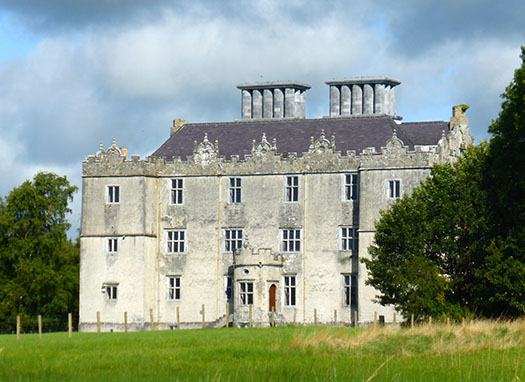
Portumna Castle – the mighty chimneys suggest even mightier heating bills. Photo: W M Nixon
Home sweet home, but far from the Baltic Sea – Triskel and her live-aboard skipper. Photo: W M Nixon
By complete contrast, back at the Castle Harbour we met up with a Polish sailor who had cruised the Baltic before he set off to start life anew in Ireland eleven years ago, and when he discovered the Shannon and all its attractions he moved aboard a little sailing cruiser eight years ago. He has lived on her ever since, in and around the Shannon lakes, and is well content, though when I guessed his boat might be an Anderson of some sort, he was very positive in making sure that I realized his beloved Triskel was an Anderson 22 Mark 2, and not one of the inferior original Mark 1 versions.
Having been bemused by contemplating the heating bills for Portumna Castle, I didn’t find out his name before he headed out of port, but by this time our skipper also reckoned it was time to go. David had an app which gave weather predictions so accurately that he could tell you exactly when the rain would fall on different parts of the lake, precisely how big the rain-drops would be, how long they’d be falling, and how much wind would be in the midst of them. Or so it seemed to the rest of us. But somehow he got us all moving together aboard ship out of Portumna Castle Harbour at morning coffee time, and we proceeded southwards down the splendid lake almost entirely in sunshine as big dark rain squalls ran north along the Atlantic seaboard to the west, while over to the east it was pitch black over mid-Tipperary and they’d some flooding. Yet aboard Slaney Shannon Star, this helmsman on the flybridge managed to get a bit of a suntan during the two hours plus passage down to Mountshannon.
From the lake, you get glimpses of other’s people’s little bits of paradise – this mini-port is one of the East Clare shore north of Mountshannon. Photo: W M Nixon
Lough Derg is 40 kilometres long (it’s 23 land miles in old money from Killaloe Bridge to Portumna Bridge) and around 20 kilometres across its widest part, but it follows the contours as befits a developing river valley to provide a handsome convoluted lake. While the coastal scenery is fairly flat up about Portumna, as you get south past Dromineer the land is rising to port and particularly to starboard, with the final approaches to Killaloe between the Arra Mountains and Slieve Bernagh becoming quite spectacular.
In classic cruising style, our skipper had decided the best way to deal with the lake was to get down to Killaloe on the first day, and then cruise back to Portumna at a much more leisurely pace. But even when you’re trying to log the miles, Lough Derg offers ample choices for quick stops, and as the weather app was talking about some decidedly lively southwest to west breezes later in the afternoon, the logical place for a stopover was Mountshannon.
This would mean that if the top did come off conditions for a while, we’d be located so that we could hold round a weather shore to get a smooth passage into the long “reverse estuary” down to Killaloe. But first, we’d to enjoy Mountshannon. It’s headquarters of the Iniscealtra Sailing Club (Iniscealtra is the neighbouring holy island, complete with Round Tower and a place of pilgrimage), but Mountshannon has the additional advantage of being serenely south-facing over a fine but sheltered bay, and it is home to an impressive fleet of yachts lying in a classic anchorage. There are the likes of Hallberg Rassys among them, and if you wondered what on earth a Hallberg Rassy ocean cruiser is doing on a lake, we suggest you get to Mountshannon and understanding will come.
An anchorage for proper yachts – some impressive craft are lying to moorings in Mountshannon. Photo: W M Nixon
We meanwhile understood that rain was coming, and fast, so after a neat bit of berthing even if I do say so myself, we nipped up to the village inn and took aboard broth and stews while the rain battered the street outside, and German and English visitors supped their pints of Guinness with that happily bemused little smile you’ll see on the faces of tourists who have discovered an Irish inn exactly as they hoped it would be, including the rain outside.
But even that cleared on cue, and we needs must visit Mountshannon’s unique attraction, the combined labyrinth and maze. A perfect opportunity for junior scouts to guide the oldies about. However, the wind had come through as expected, so much so that Mountshannon’s famous white-tailed sea eagles appeared to be grounded for the afternoon. But though Slaney Shannon Star was sitting serenely in a wellnigh perfect berth for a stormy night, the menfolk were just too interested in seeing how she’d perform in a real breeze of wind, with a bit of a sea running, to stay on in the same place.
Slaney Shannon Star snugly berthed at Mountshannon. The front is going through, and the wind has veered, but there’s enough of it to keep the sea eagles of Mountshannon grounded. Photo: W M Nixon

There really is a maze at labyrinth at Mountshannon, but it takes an aerial photo to show them properly
“It’ll only be slightly lumpy for a few minutes” was the mantra. And it has to be said the old girl coped superbly, though fortunately all warps had been lashed in place, as for a little while -until we were feeling the shelter of the Clare coast in under the delightfully-named Ogonnelloe – some quite substantial quantities of Lough Derg were sweeping at speed over the Slaney Shannon Star.
Sea test – Slaney Shannon Star finds a bit of a sea running on the lake. Photo: W M Nixon
For a while, quite a lot of Lough Derg was sweeping over Slaney Shannon Star on passage from Mountshannon to Killaloe, but it didn’t take a feather out of this able boat – those towels are laid out to dry, not to cope with leaks. Photo: W M Nixon
But in the Killaloe estuary, relative peace returned, the black clouds raced away to the east, the sun came out with a rainbow, and there was this sense of approaching somewhere important, heightened by the quality and variety of the lakeside and hillside houses. Some people find this Irish scattering of houses, each in its own little world, to be something of an irritation among some rather fine scenery. But I like it. There’s more than enough empty uninhabitable wilderness in the world, and except for the most spectacular mountains, Irish scenery is enlivened by houses dotted here and there in such a way that you think pleasantly of the agreeable way of life that might be found in them.
The storm squall has passed, and the lush country of the Tipperary shore is seen at its best with a rainbow in the approaches to Killaloe. Photo: W M Nixon
Once we were into the smooth water, Madam got on the phone to suss out the possibilities of an “Objective Achieved” supper at the renowned Cherry Tree on the Ballina side of Killaloe, and of course chef patron Harry McKeown himself answered the phone and recognized her voice immediately. But he went through the formality of booking a table for six in impersonal style before letting her know her cover was blown.
Whatever about Georgina’s problems in dining anonymously, for the rest of us it made for a idyllic evening, with the boat berthed as conveniently as possible at the berth generously provided by the Lakeside Hotel, the shortest walk imaginable to the Cherry Tree, a riverside window table to admire a sister-ship berthed directly across the water on the Killaloe side, and food glorious food while the light lingered in a fair approximation of a summer’s evening.
Our first berth at Killaloe was at the hospitable Lakeside Hotel on the Ballina shore. Photo: W M Nixon
Mission accomplished – the team have reached The Cherry Tree for dinner in Killaloe. Photo: W M Nixon
An interest in visiting Killaloe Cathedral in the morning had been expressed, so lo and behold our thoughtful skipper moved the boat across river in the morning on his own while the rest of us were still bestirring ourselves, thereby removing the need to walk across Killaloe’s ancient but much overworked bridge. It suffers from ludicrously excessive traffic – the lovely little riverside town does really urgently need a by-pass and the long-planned new bridge to the south. But St Flannan’s Cathedral well exceeded expectations. It’s of very modest size for anyone expecting a Shannonside version of Chartres or York Minster. But we knew it well from the outside, yet going in was a revelation, a haven of total peace in this Cathedral of the Waterways.
The Cathedral of the Shannon – St Flannan’s at Killaloe is on the banks of the old canal to Limerick which pre-dated the Ardnacrusha development. Photo: W M Nixon
A soothing place - Killaloe Cathedral. Photo: W M Nixon
Busy place - Killaloe is very much the southern capital of the Shannon waterway. Photo: W M Nixon
There seemed to be an unspoken agreement that we weren’t going to break the spell of peace by walking across the bridge, but as this meant the kids couldn’t avail of the playground on the Ballina side, it was a case of up sticks and away from the impressive new Waterways Ireland pontoons on the Killaloe side, and off we went north and east to Garrykennedy with its handy playground, on the way passing learner sailors in action off the University of Limerick’s Activity Centre on the Clare shore, and then – for it was a pleasant sunny sailing day after Wednesday’s weather kerfuffle – we passed a real live sailing cruiser going on her merry way, plus several powercruisers.
With lighter winds, sailing can resume at the University of Limerick Activity Centre near Killaloe. Photo: W M Nixon
Waterside paradise - lakeshore house near Killaloe. Photo: W M Nixon
The guess is it’s a Halcyon 23 enjoying the breeze on Lough Derg – and taking in one’s fenders is optional on the lakes. Photo: W M Nixon
All the little ports about Lough Derg have their own individual character, and Garrykennedy is about as different as possible from Killaloe, which in turn is very different from Mountshannon, while Dromineer – where we were to spend the night – is different again.
But most of the ports popular with today’s sailors on Lough Derg have it in common that once they were part of a busy waterways transport system, each with its own little mini-harbour which could accommodate the barges which might have come all the way from Dublin via the Grand Canal. The cream of the fleet were engaged in the sacred task of conveying Guinness’s Porter from St James’s Gate Brewery all the way to the connoisseurs of Limerick, whose tastes were and are so pernickety that when any variant in any product is contemplated in the Guinness organisation, somebody always wonders how it will do in Limerick…
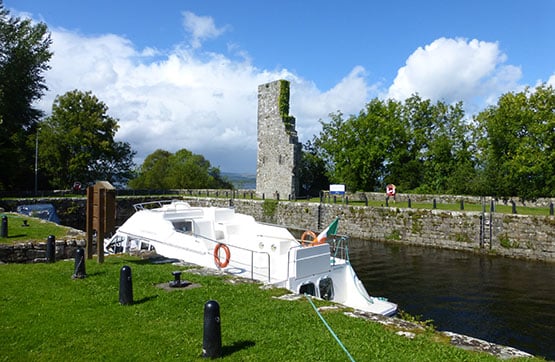
Garrykennedy’s little harbour was created inshore of the 15th Century castle of the O’Kennedys. Photo: W M Nixon
Larkins of Garrykennedy is one of the most popular food pubs on Ireland’s inland waterways. Photo: W M Nixon
The décor in Larkin’s of Garrykennedy includes this superb half model of a Shannon One Design OD made by Reggie Goodbody of Dromineer. Photo: W M Nixon
So keen is Limerick to get its Guinness that in a storm one winter a canal boat (they were never called barges in their working days) headed out after sheltering in Garrykennedy and sank off Parker Point taking some of her crew down with her, but that’s a sad story for another day. For we got into Garrykenedy on a sunny day to find a handy berth in the old harbour, a good lunch in Larkins, and a classic Children’s Playground with real old-fashioned swings where Matthew and Julia proved fearless.
By the time you’re a day or three into your Waterways holiday, you lose track of time, but I think it was later that afternoon when the Slaney Shannon Star headed in the sunshine across to Dromineer. There, we found the most-sheltered spot at the quayside in the harbour was entirely taken up by a slovenly-berthed J/24 which, if it had been secured in a more thoughtful manner, would have left plenty of room for other boats.
However, the nearest handy berth put us right beside the playground, so bonus points for Dromineer. And then, as we had access to sheltered water, it was time for a bit of fun with the outboard dinghy, which was a winner with the kids, who were soon helming it with skill. You’d expect that of Matthew – he has helmed a Howth Seventeen – but Julia at just three years old was a very cool and quick learner.
The berth at Dromineer was ideal for family cruising, being right beside the children’s playground. Photo: W M Nixon
Outboard dinghy sport at Dromineer. Photo: W M Nixon
Matthew in charge, and The Diva not too pleased. Photo: W M Nixon
The Whiskey Still at Dromineer is a Lough Derg institution. Photo: W M Nixon
An overnight in Dromineer means supper at The Whiskey Still, and very good it was too, a real local which comes pleasantly to life as the evening draws on, and lots of folk to talk to about this intriguing place, which in the great days of Waterways transport, was by way of being the main port for North Tipperary. But since 1835 it has also been the home of Lough Derg YC, whose fine clubhouse was taking a brief rest between the excitements of the annual Lough Derg week and the imminent arrival tomorrow of the international fleet of cruising-racing Wayfarer dinghies.
The last walk of the day for Pippa discovered an energetic game of kayak polo under way off Dromineer’s little beach (yes, they really do have a beach, the immaculately-kept Dromineer has everything) but later that night the breeze freshened again and our fenders were squeaking a bit. We couldn’t be having that at all, so the skipper found us enough room along the other quay for us to warp into a berth where the breeze held us noiselessly off the wall for a night of peace.
Kayak polo at Dromineer. Photo: W M Nixon
Dennis Noonan of Round Ireland race fame on his Pegasus 800 Photo: W M Nixon
By this time we were so totally into Waterways time that I haven’t a clue when we left Dromineer next day, but we seem to have crowded several days of living into a morning. The playground had to be given a thorough work-over, the dinghy had to be taken out for a spin at least twice, then Pippa had her morning walk along to Shannon Sailing’s secluded marina where of all people we met up with the great Dennis Noonan of Wicklow and Round Ireland Race fame. He was aboard his able little Pegasus 800 which is for sale, and is a fine sailing cruiser if you’re interested in a proper yacht with full standing headroom. But there was little enough time to discuss boat sales, for in real life Dennis is a market gardener of long experience, so he and Georgina were immediately at it yakking away about genuine local produce and how to get people to appreciate what their neighbourhood can produce in season.
I meanwhile wandered off meet up with Robbie the Main Man in the workshop, and soon discovered he was the owner of an enormous 95ft boat – the Spera In Deo - which was lying in Dromineer harbour, a former Dutch mussel dredger which he had discovered in a ruinous state in Donegal after a fire. He was able to make her sufficiently seaworthy to bring her south along the Atlantic seaboard and into the Shannon crewed by all the usual gallant suspects, and while he still has much cosmetic work to do to the exterior, he has fitted out the interior in the most extraordinary way to make her the biggest four berth motor-cruiser in the world, as there are two enormous en suite double cabins - one with a Jacuzzi - while the headroom in the vast main saloon is theatrical in scale.
95ft of the biggest four berth motor cruiser on the Shannon – the Spera In Deo at Dromineer. Photo: W M Nixon
To grasp the scale of the Spera In Deo’s interior, you have to realize those are full-height interior doors for a house. Photo: W M Nixon
Eventually I was reunited with my brood in the Lake Café right on the harbour. It’s open from 8.30am until 5.0pm, which makes for a very civilised little village arrangement as The Whiskey Still then opens up for food. Declan & Fiona Collison, who run the Lake Café, used to run The Whiskey Still, so they know the Lough Derg hospitality scene inside out. But like everyone along this ancient waterway, they are as keen to talk about its fascinating past are they are interested in its present and future, and the Lake Café’s walls are adorned with aerial photos of Dromineer from around 1967 which really do bring home to you how much Ireland has moved on during the past half century.
Breakfast in Dromineer – Georgina, Matthew and Julia have the first of the day’s five meals….. Photo: W M Nixon
Dromineer as it was in 1967 – photo courtesy Lake Café.
Heading up-lough in “vivid sunshine”. Photo: W M Nixon
Not everything has come through intact or improved, however. Heading up-lough later that day in vivid sunshine, we went close past Illaunmore, Derg’s biggest island, where very many years ago we discerned what looked like a tiny creek leading to a little harbour. Though it was obviously private, our curiosity got the better of us, and we negotiated our motor-cruiser through the narrow gap to find a harbour. There was a small waterside chalet and a man out for a walk with his very tame golden pheasant, which we later learned was called Sammy. This was the late Martin Winston, and Illaunmore was the love of his life. He was never happier than when on his own island. But that was a long time ago. Martin Winston is long gone. And as far as we could see, the lovely little harbour where we were made so welcome with a fantastic spontaneous party generated within minutes, it now all seems completely overgrown.
But while the harbour in Illaunmore may have disappeared in the undergrowth, the other port of that day’s cruising so long ago, Terryglass, has come on with leaps and bounds. Indeed, when we visited Illaunmore with its fine little harbour, there was virtually no harbour at all at Terryglass, you berthed in a sort of creek where cattle came to drink lake-water. And the first time we were there being Hallowe’en night, the track up to the village where a friend had just bought the pub was quite a spooky experience.
Terryglass has become a busy port in the past three decades. Photo: W M Nixon

It’s always an irresistible challenge to try and disappear into the reeds. Photo: W M Nixon
But today Terryglass is one of Lough Derg’s more glamorous ports, while it’s a special place for David and Karen, as they were married in the lovely church in the village, that church whose spire is “Conspic” from all parts of the north end of the lake. But when you’ve a couple of lively kids, there’s no time to be sad or serious about the old days and disappeared harbours or new harbours and whatnot. They’ve splendid reed beds at Terryglass, and disappearing completely into the reeds is a natural challenge for youngsters with an outboard dinghy, so that was on the agenda before we ambled up to the village and supper in the Derg Inn.
It wasn’t a restaurant crawl we were on by any means, but brisk days on the lake are great for the appetite. That last day was typical. We’d the usual good breakfast on board, then after everyone went off on their various pursuits, we’d one of those light “Meals-without-a-Name” with the Collisons at the Lake Café, as their baking is superb. Then when we berthed in Terryglass, somehow Karen had another meal-without-a-name ready on the saloon table, followed by more reed-bashing-by-boat, and then with the kids needing an early meal followed by a reasonable bedtime, we fed well but early in the Derg Inn.
Not for the faint-hearted (1): The Pineapple Boat in the Derg Inn. Phot: W M Nixon
Not for the faint-hearted (2): On the swings at Terryglass. Photo: W M Nixon
There, I fearlessly rounded out the feast with a Pineapple Boat with strawberry ice-cream, raspberry coulis and cream – definitely not a nibble for the faint-hearted. Then back at the harbour where the kids went to the limit and beyond on old-style swings in the playground, with people arriving down to join their Terryglass-based cruisers for the weekend we could admire an extraordinary selection of dogs even unto an Irish wolfhound, and not a lifejacket among them except for Pippa. And after all that, the little people went willingly to bed, and in truth the rest were soon headed the same way.
Canine old mates of Terryglass harbour. Photo: W M Nixon
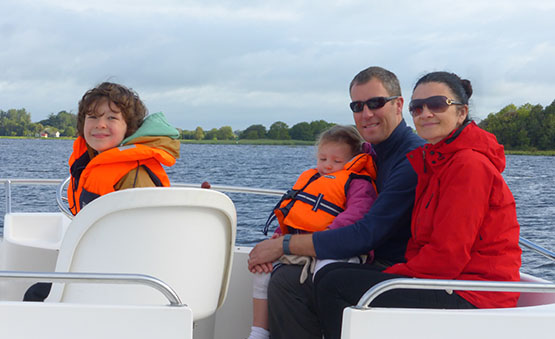
The end of a busy week – Mattthew, Julia, David and Karen on the final morning. Photo: W M Nixon
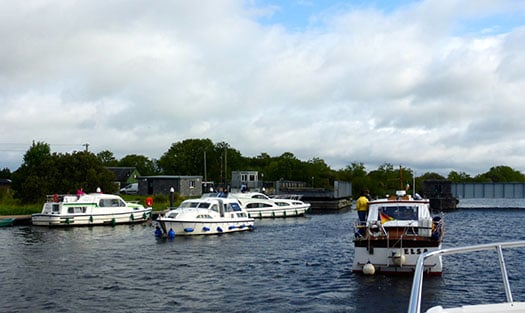
The bridge opening at Portumna is both a beginning and an end. Photo: W M Nixon
Changeover Saturday at a hireboat base is so busy there’s not time to be sad that it’s all ending. We were perfectly on time across from Terryglass for the 0945 bridge opening at Portumna, there was a berth stern-to right beside the cars, there was the usual final check round to make sure we’d left nothing behind, and then we were gone, only pausing briefly to hope that whoever next took the gallant Slaney Shannon Star down the short channel to the river and the lake was going to have at least half as good a time as we’d had.
But now the grandparents weren’t too tied to time. We could go home at leisure, ambling by road on up the Shannon, stopping here and there at river ports which are very different in character from lake harbours. Yet all have their special charms, so it was after dark when we finally got home. It wasn’t until Sunday that we finally opened Saturday’s Irish Times. And there was the announcement that Peter & Mary Ward’s fantastic weekly display of everything good in the Milk Market in Limerick had won the prize for the Best Market Stall in Ireland.
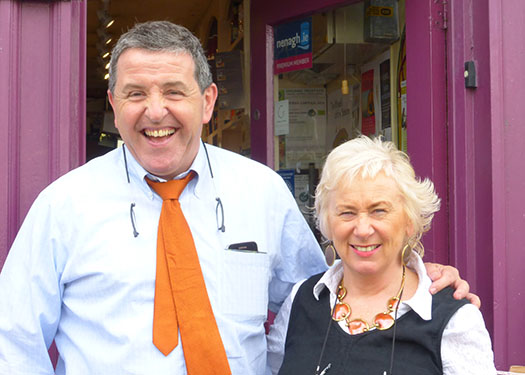
Winners! Peter & Mary Ward of Country Choice in Nenagh. Photo: W M Nixon
#royalcanal – Spencer Dock Sea Lock at the Royal Canal in Dublin has been closed til further notice due to unforeseen repair requirements at one of the lock gates.
Upcoming Newcomen Bridge Lifts are also cancelled until these works can be carried out.
Waterways Ireland has apologised to customers for inconvenience caused and say they will issue an update notice when further information is available.
#ulstercanal – Minister Humphreys joined Waterways Ireland on site this morning at the start of project works on the Ulster Canal at Derrykerrib Bridge.
After many years of planning and consideration, the Ulster Canal project has reached the stage of equipment on-site in the first phase of works required to extend the Erne navigation from its existing limit at Quivvy Lough to Castle Saunderson Estate. Minister Humphreys secured the approval from Government to proceed with the project in February 2015 and Waterways Ireland have moved quickly to ensure progress is made. This project has the potential to act as a catalyst for the regeneration of this border area. It will provide a wonderful recreational facility for local communities and should act as a significant draw for tourists.
The 3km channel will involve the construction of a new canal cutting and associated bridge with improved 'air draft' as the current Derrykerrib Bridge lacks sufficient space for boats to pass underneath. It is also planned to dredge the River Finn to increase depth for navigation.
On site the Minister saw ground investigation work being undertaken in advance of the main contract. The site investigation information will be used to inform the detailed design stage of the project. The site investigation works will consist of boreholes, trial pits, river bed sampling and contaminant analysis.
Minister Heather Humphreys said "After so many years of talking, it is great to finally see works underway on the restoration of the Ulster Canal between Upper Lough Erne and Castle Saunderson. After securing approval from the Government for this project earlier this year, I have been very keen to see works getting underway as soon as possible.
I have no doubt that this project will act as a catalyst for the regeneration of this border area. It will provide a wonderful recreational facility for local communities and will help to attract tourists into the region.
I am also very pleased that Waterways Ireland is working with Monaghan County Council on the possible development of off-road cycling and walking facilities along the route. This would help to further maximise the benefits of the restoration of the Canal for the wider community."
Dawn Livingstone, Chief Executive, Waterways Ireland confirmed "Waterways Ireland is proceeding with the work on the Ulster Canal as Minister Humphreys has secured the approval needed. Preliminary works will be completed shortly enabling Waterways Ireland to begin dredging in summer 2015 and to have the works completed to Castle Saunderson in 2016. "
Ulster Canal Restoration To Commence From Lough Erne to Castle Saunderson
#ulstercanal – Waterways Ireland has welcomed the announcement by the Minister for Arts, Heritage and the Gaeltacht Heather Humphreys that she has secured Government approval for the restoration of an initial section of the Ulster canal from Lough Erne to Castle Saunderson.
Waterways Ireland has received planning permission for this work.
Work on the Ulster Canal will involve dredging a 2km section of the Erne River and the construction of a new navigation arch at Derrykerrib Bridge to accommodate boat traffic.
Work will commence on the project in April 2015 and is expected to be completed 12 months later.
Dawn Livingstone Chief Executive of Waterways Ireland stated "The development of the Ulster Canal will be a welcome economic and tourism boost to the area. Waterways Ireland will continue to work closely with the Minister and her officials to bring this project to a successful completion."
IWAI & The Waterways of Ireland – New Book By Brian Cassells
#inlandwaterways – When English writer LTC Rolt made a round trip from the Shannon to Dublin in 1946, traversing the Grand and Royal Canals, he was considered an eccentric. In the 1940s commercial traffic on the canals and rivers of Ireland had dwindled to almost nothing. Rolt's notion that these waterways could be a source of joy to leisure boaters was considered pure whimsy. But it was the book Rolt published after this trip, Green and Silver, that was to act as inspiration for the formation of the Inland Waterways Association of Ireland (IWAI) in 1954.
There were other catalysts, too, that fired up the Association. The swing bridge at Athlone was to be replaced with a fixed span. The Royal Canal had already fallen into disrepair and was closed to navigation. Dublin Corporation proposed to lay a sewer along the Grand Canal and fill it in to make a road. The IWAI determined to oppose the authorities in their attempts to impede and close the network of waterways.
IWAI and the Waterways of Ireland is a celebration of sixty years of the Association doing just that. It begins with a rattle through the waterways themselves – the many rivers, lakes and canals. A short history of the IWAI follows, interesting as much for the names listed at the inaugural meeting as for what was achieved. Two of these were Colonel Harry Rice, retired from the British Army, and Sean McBride, dedicated Republican, politician and Nobel prize winner. Brian Cassells, writer and compiler of this book, comments 'I smile when I think of a dedicated Republican being best friends with a retired Colonel of the British Army.'
This fact says much about the compelling charm of boating in Ireland – it is a great social leveller. The portraits of people include George O'Brien Kennedy, boat designer; Syd Shine, showband leader; Rosemary Furlong, RNLI fundraiser; Jim McGarry, skipper. A diversity of people who were passionate about the rivers and canals, the boats and buildings.
The backbone of the IWAI remains the branches, and these are covered in full. It is the reasons for their creation, and the progress made, that make these descriptions come alive. How local opinion in Kenagh on the Royal Canal was certain it would never be re-opened (it was). Volunteers working on the Lagan Navigation clocking up 11,000 hours to restore Ireland's only flight of four locks. Coalisland branch members who possessed not a boat between them, dedicated to saving their canalside heritage.
The IWAI still has a campaigning role. There are notable successes in the book, given their own special pages – Ram's Island on Lough Neagh, the Royal Canal, and the Boyne Navigation. There is hope for the restoration of the Ulster Canal.
Brian Cassells has put together a book of immense charm, lusciously produced, rich in photographs. There is some repetition of facts, perhaps inevitable in a book with many different contributors. Nonetheless it is a valuable record of, and insight into, an organisation which has been instrumental in safeguarding a network of waterways that is among the most beautiful in Europe.
Shannon Sailing Acquire Lough Derg's Williamstown Harbour
#loughderg – Lough Derg boating firm Shannon Sailing Ltd has acquired Williamstown Harbour in Williamstown, Whitegate, Co. Clare.
The harbour was seen by Shannon Sailing Ltd as 'a perfect location' to expand its marina footprint on Lough Derg. The intention is to bring back Williamstown Harbour to its former glory and establish it as the premier marina on the Clare Shoreline.
Williamstown Harbour was built in 1834 when the Dublin Steam Packet company set up its base there.
Williamstown harbour was acquired on Tuesday 8th October 2014. Located at Williamstown, Whitegate Co. Clare, the property boasts berthing for 25 boats, slipway, workshop, storage facility, diesel facilities, showers, toilets, offices, rental accommodation as well as a number of Motor Cruisers. Denis Dillon of Shannon Sailing said: 'Our Team are very excited about this project and feel with our experience in marina management and providing professional services through our workshop, chandlery shop and training centre that customers in both our Marinas in Williamstown harbour and Dromineer will see the ongoing benefits.
Farmers Play Key Role In Proper Management Of Watercourses
#Angling - Proper management of farm watercourses – whether large rivers or small streams – is critical to ensuring high levels of biodiversity, according to a new leaflet jointly produced by Teagasc and Inland Fisheries Ireland (IFI).
Speaking at the launch of Minding our Watercourses last week, Catherine Keena, countryside management specialist with Teagasc, emphasised the importance of farming in harmony with nature and biodiversity.
“The marketing of Irish farm produce relies on our ‘green’ environmental image," she said. "Watercourses contribute significantly to biodiversity, often being the most valuable habitat on the farm.”
IFI chief executive Dr Ciaran Byrne acknowledged the important role of farmers in the management of watercourses. “Smaller streams, even where no fish are apparent, are critical to the biodiversity of the catchment," he added.
There are 29 species of freshwater fish found in Ireland's waterways, with 14 native species present since the last Ice Age.
The leaflet shows there are different places for different species and life stages within watercourses: salmon and trout spawn on gravels in winter; lamprey spawn on gravels in late spring and summer; coarse fish lay their eggs in weedy parts of the channel; salmon and trout use riffles in the first year and move to deeper water as they grow larger; and juvenile lamprey live buried in silty margins of watercourses.
The new leaflet details best practice management of watercourses. Fencing and providing an alternative source of water is recommended as this avoids damage to the river bank and bed, reduces siltation, prevents fouling with pathogens and prevents the escape of nitrogen and phosphate.
Allowing native trees to grow along watercourses stabilises banks, creates a natural buffer zone, provides valuable habitat for flora and fauna, controls in-stream temperature and weed growth and provides shade and shelter for livestock. Buffer strips alongside watercourses intercept silt, nutrients and improve bank stability.
Farmers are reminded to watch out for and report invasive plant species which smother out smaller native species, which die back to leave large bare areas in winter, resulting in soil erosion.
Fish and their spawning grounds are protected under the Fisheries Acts (1959-2010). In-stream works should not be carried out without prior consultation and the approval of Inland Fisheries Ireland.
If maintaining watercourses, the advice is not to disturb the non-working bank slope; retain vegetation at the water’s edge; leave the working bank slope intact; remove vegetation and silt material from the open channel only; not to remove stone or gravel place spoil along the bank outside the bank-full line, spreading thinly; and leave a buffer of 20 metres at the downside end of a drain to act as a silt trap.
Waterways Ireland Blueway Canoe Trail Launch
#blueway – Waterways Ireland advises masters and owners that the Waterways Ireland Blueway launch event will take place on Sat 11th October a large fleet of canoeists will assemble at Drumshanbo Lock at 1130hrs and proceed to Acres Lake for 1200hrs for the formal launch of the Waterways Ireland Blueway Canoe Trail. Thereafter the fleet will proceed downstream towards Leitrim Village to arrive by 1500hrs.
Masters should proceed at slow speed when approaching this stretch of waterway during the event and note any directions issued by the organisers and safety marshals controlling the event. Masters are reminded to keep their wash low to avoid upsetting canoes and other low freeboard craft associated with the event.
Lough Derg Gets Its Own Dedicated Tourism Website
#loughderg – Minister for the Environment, Community and Local Government Mr. Alan Kelly TD today launched a brand new website dedicated exclusively to the promotion of the inland waterways of the Lough Derg region.
www.discoverloughderg.ie provides visitors to the region with information on places to visit, events, accommodation providers and restaurants, special offers, and land and water based activities.
The website is one of a number of marketing initiatives being rolled out over the coming months and during 2015 to establish the Lough Derg area in counties Clare, Galway and Tipperary as Ireland's premier lakeland destination.
"Lough Derg is the most important tourism asset in this region, and the lake has the capacity and the potential to entice and host domestic and international visitors alike," stated Minister Kelly at the launch of www.discoverloughderg.ie.
The Minister added: "We need to continue to work on increasing the demand for lakeside and leisure activities and attract tourists into the Lakelands Lough Derg Region. An online presence is just one activity to assist us in doing this".
Minister Kelly confirmed that a €2million stimulus package is being invested to progress the objectives of the "Roadmap for Experience Development and Destination Marketing Plan 2014-2017" for Lough Derg, which was launched earlier this year.
Implementation of the Plan is being co-ordinated by the Lough Derg Marketing Group (LDMG), comprising Fáilte Ireland, Waterways Ireland, Inland Fisheries, Clare, Galway and Tipperary County Councils, LEADER and tourism trade representatives from the private sector.
In addition to the website, the LDMG has coordinated a promotional video for the Lakelands Lough Derg Region, which is available to view on the newly launched website and which local tourism businesses are encouraged to incorporate into their websites. Lakelands Lough Derg will also be promoted on websites across France and Germany later this year, while a domestic marketing campaign is planned for the national print and broadcast media in early 2015.
Joe MacGrath, LDMG Chairperson and Chief Executive of Tipperary County Council commented: "One of the key objectives outlined in the Roadmap is to improve orientation around Lough Derg for visitors. This will be achieved by erecting new signage to create a sense of arrival and enhance the visitor experience in exploring the area. It will focus on the three counties of Clare, Tipperary and Galway that border the lake with signage from motorways to the regional and local roads included in the scheme. Work is progressing in relation to this project and new signage is expected to be put in place in 2015".
"The marketing and promotion of Lough Derg is an ongoing process," explained Áine Mc Carthy, Tourism Marketing Coordinator for Lough Derg, who added: "For example, the Lough Derg Marketing Group launched a pilot food tourism initiative, A Taste of Lough Derg 2014, in June of this year which became an instant success generating public attention on social media through a series of events organised by the tourism trade in July and August. The initiative, which continues this month has created a significant interest in local produce available around Lough Derg and has heightened awareness of Lough Derg as a food tourism destination".
"The initiative will be extended next year to get more of the tourism trade involved, with more events taking place throughout the summer months offering visitors to Lough Derg a choice of food events to attend," added Ms. Mc Carthy.
Meanwhile, the LDMG has been involved in an EU Project called TRAP (Territories of Rivers Action Plans) since March which involves improving stakeholder engagement around Lough Derg.
Businesses wishing to be added to www.discoverloughderg.ie or to have their details updated should send an email to [email protected].
Waterways Ireland Speaks Out Over Barrow Blueway Concerns
#InlandWaters - Waterways Ireland has responded to concerns over preparatory works connected with the proposed Barrow Blueway.
Described as one of the key recommendations of the Barrow Product Development Study, the development of a 'blueway' scheme along the Barrow Line and Barrow Navigation is still in its "early survey work" stages before any further steps in the planning process, according to the cross-border body for Ireland's inland waterways.
"If the environmental reports are favourable, Waterways Ireland together with the eight agencies [Carlow, Kilkenny, Kildare and Laois County Councils and four Leader companies] will formally apply for planning permission in early 2015," it said in a statement.
"Contrary to speculation, the proposed development of the trackway would entail the use of clean stone and compacted quarry dust to a maximum width of 2m similar to that which is already in use along some of the trackway.
"It is the intention of the agencies to develop this trackway as a sustainable multi-activity leisure route from Lowtown to St Mullins and ultimately linking Dublin to Waterford."
Waterways Ireland also underlined that the Barrow Blueway "is entirely focused on sustainable rural regeneration and development through the provision of a recreational and tourism product of economic and social benefit to the local communities.
"For example, the Great Western Greenway in Mayo of shorter length, contributes an €7.2m annual to the local economy and has helped create 38 new full time equivalent jobs and sustained another 56 jobs."
However, many locals - including broadcaster Olivia O'Leary - have expressed their "horror" at any attempt to disturb the present towpath, a matter that was up for discussion on KCLR FM's Sue Nunn Show last Thursday 14 August.




























